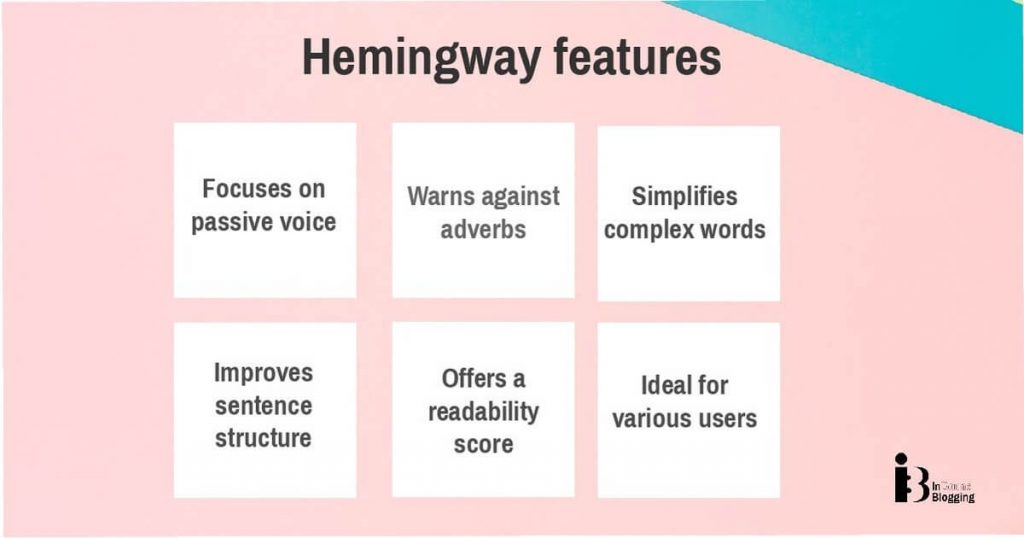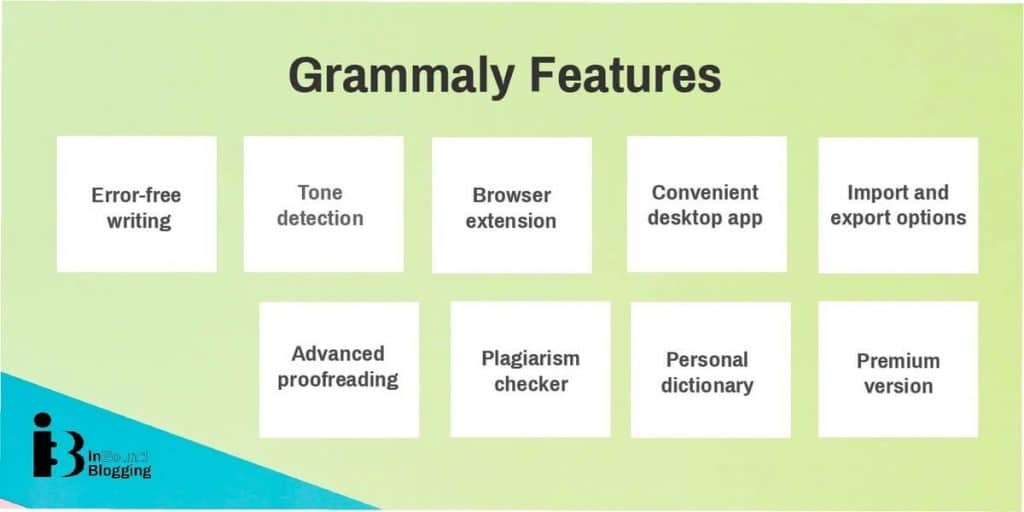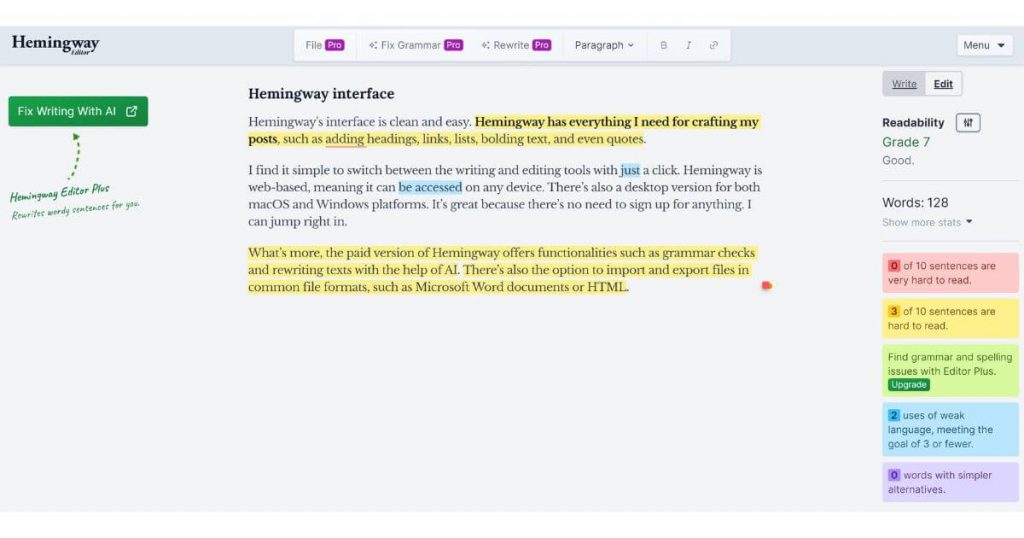Deciding on the right writing enhancement tool can be a real challenge. I’ve delved into the depths of text improvement apps myself, searching for the perfect fit.
This comparison between Hemingway vs Grammarly sheds light on two popular choices, highlighting their unique capabilities to polish grammar and clarify your written message.
Let’s dive right in.
Grammarly vs Hemingway App 2024 [Key Takeaways]
- Hemingway is great at making your writing clear and bold. It warns against using the passive voice and too many adverbs, suggests simpler words, and gives you a readability score. You pay a fee of $19.99 once, and it’s yours forever.
- Grammarly checks spelling, grammar, punctuation, capitalization, and more. It also checks your tone of voice and offers suggestions based on the mood of your words. The free version helps with basic mistakes, while the paid plans offer deeper analysis for better clarity.
- Using Hemingway or Grammarly depends on your writing needs. If you want to focus on grammar accuracy and error-free writing, go for Grammarly. If you’re looking to make your sentences straightforward and impactful without losing meaning, the Hemingway app might be the tool for you.
Overview of Hemingway and Grammarly
I always look for tools that simplify my writing process, making my content clear and engaging. Both Hemingway and Grammarly check my text to make improvements, but they do so in different ways.
Hemingway features

The Hemingway app stands out as it sharpens my writing, ensuring every sentence hits the mark.
Here are the key features I value most about Hemingway:
- Focuses on passive voice: It highlights when I use the passive voice, pushing me toward more direct and powerful sentences.
- Warns against adverbs: Too many can weaken writing. This app flags them, helping me find stronger verbs.
- Simplifies complex words: It suggests simpler alternatives to big or complex words that might confuse readers.
- Improves sentence structure: If my sentences are hard to follow, it tells me to break them down.
- Offers a readability score: Based on the Flesch-Kincaid grade level, it shows how easy or hard my text is to read.
- Ideal for various users: Whether creatives or non-native speakers, it helps refine everyone’s writing style without losing meaning.
Phil Strazzulla, the founder of SelectSoftware Reviews, shares a brief success story with Hemingway:
“A client of ours used Hemingway to refine their customer service responses. They saw an increase in customer satisfaction ratings due to clearer and more direct communication.”
Grammarly features

Grammarly has changed how I write. It’s like having a personal editor who underlines mistakes and polishes my work.
- Error-free writing: Grammarly checks spelling, grammar, punctuation, capitalization, and text consistency.
- Tone detection: It reads the mood created by my words and suggests changes to match my intended tone.
- Browser extension: I can easily use Grammarly on any website, including Google Docs, where I draft blog posts.
- Convenient desktop app: Editing large pieces of content is easy since it offers a distraction-free environment.
- Import and export options: Grammarly lets me transfer edits between devices. Furthermore, I can add the app to Microsoft Office products, such as Microsoft Word, so that I can work on documents offline.
- Advanced proofreading: It goes beyond basic spell checks to offer suggestions for improving clarity and conciseness. For further quality assurance, Grammarly gives me the chance to hire human proofreaders.
- Plagiarism checker: This is a game-changer for me, ensuring my content is original.
- Personal dictionary: It allows me to add unique or niche terms so they won’t be flagged as errors in future documents.
- Premium version: With the paid version, I see advanced issues such as passive voice usage or hard-to-read sentences, making my writing more engaging.
Here’s what Vinika Garg, the Chief Operating Officer of Webomaze, shares about Grammarly:
“Sometimes, readers can misinterpret or misunderstand the tone of the content. As a result, they won’t pay attention to the rest of the content or may not understand the intention of the content. Grammarly’s [artificial intelligence] AI tone enhancement can identify such sentences and give the best suggestions to rewrite them. After taking its help, the rewritten sentences make the content more reader-friendly.“
User Interface and Experience
Talking about how simple it is to use Hemingway and Grammarly, you’ll see a clear difference between the two. Let me explain it to you.
Hemingway interface

Hemingway’s interface is clean and easy. Hemingway has everything I need for crafting my posts, such as adding headings, links, lists, bolding text, and even quotes.
I find it simple to switch between the writing and editing tools with just a click. Hemingway is web-based, meaning it can be accessed on any device. There’s also a desktop version for both macOS and Windows platforms. It’s great because there’s no need to sign up for anything. I can jump right in.
What’s more, the paid version of Hemingway offers functionalities such as grammar checks and rewriting texts with the help of AI. There’s also the option to import and export files in common file formats, such as Microsoft Word documents or HTML.
Grammarly interface

I find Grammarly’s interface super easy to use, with no clutter. After creating my free Grammarly account, it started checking my work immediately, and the dashboard was intuitive. Grammarly also offers a performance score, text uniqueness checker, language settings, and a personal lexicon, helping me fine-tune my writing without feeling overwhelmed.
Grammarly is available everywhere, from the web to Android, iOS, Windows, and Mac devices. Plus, there’s a browser extension for Chrome, Firefox, Edge, and Safari. The real-time grammar-checking feature is handy for emails and social media.
I can upload documents or copy and paste my texts directly into Grammarly. This saves time, eliminating back-and-forth transfers between programs.
Want to compare Grammarly against another grammar checker? Dive into my comprehensive comparison of Grammarly and Linguix to elevate your writing game.
Pricing and Subscription Options
Whether you’re just dipping your toes into content writing or you’re a seasoned pro, knowing your tools and their costs is crucial.
Grammarly pricing (free vs. premium)
There are three versions available of this grammar checker. The free version comes at no cost and offers limited reports and basic writing corrections. Here’s what else there is in terms of pricing options:
- Premium version of Grammarly: It costs $12 per month when billed annually or $30 per month when billed monthly.
- Business version: It is priced at $15 per month when billed annually or $25 per month when billed monthly.
- Enterprise Plan: Its price is available upon request.
Grammarly has gotten even smarter with GrammarlyGO— an editing and writing tool that’s based on AI. However, it’s only available for the desktop version for now.
With a Grammarly free plan, you receive a monthly allowance of 100 AI prompts. For Grammarly Premium and Business users, the number of prompts rises to 1,000 per month and 2,000 per user per month, respectively.
Hemingway pricing (free vs. paid)
The free version of Hemingway offers limited editing options without requiring a login and is available at no cost.
The Hemingway App for macOS and Windows, which includes offline mode, document saving, and export to different file types, is available for a one-time payment of $19.99.
For more advanced features, Hemingway Editor Plus includes an AI editor that simplifies and clarifies your piece of writing. This version has various pricing plans:
- Individual 5K Plan: It costs $8.33 per month when billed annually or $10 per month when billed monthly.
- Individual 10K Plan: It is priced at $12.50 per month when billed annually or $15 per month when billed monthly.
- Team 10K Plan: It comes at $12.50 per month when billed annually or $15 per month when billed monthly.
Have you heard of Trinka AI? That’s another grammar tool. Check out my full Trinka review.
Pros and Cons: Hemingway vs Grammarly
Without further ado, I’ll walk you through my summary of the best qualities and drawbacks of these two tools.
Hemingway pros and cons
| Pros | Cons |
| Helps identify lengthy, complex sentences and encourages simplification | Limited formatting options, not suitable for long-form writing |
| Promotes the use of the active voice over the passive voice | No comprehensive grammar or spelling check in the free version |
| Provides an overall readability grade level for the text | Suggestions can be too prescriptive and should be viewed as options |
| Integrates with various platforms such as WordPress and Medium | Lacks the depth of analysis and features of alternatives, including Grammarly or QuillBot |
| Highlights adverbs and weak words that can be improved upon | There’s a risk for users to overemphasize brevity |
| Offers a distraction-free writing environment to focus on clarity and brevity | Should not fully replace professional editing services |
Grammarly pros and cons
| Pros | Cons |
| User-friendly interface and design | May be costly to some users |
| Comprehensive grammar, spelling, writing, and plagiarism checking | Suggestions may not account for intentional stylistic choices |
| Integrates with various platforms such as Word, Chrome, and Google Docs | Requires a paid subscription to access advanced features and remove ads |
| Customizable writing preferences to match team style guides, goals, audience, domain, different English dialects, etc. | Collects user data, which may raise privacy concerns for some users |
| Provides AI-powered writing suggestions through GrammarlyGO | Suggestions may not always be accurate or appropriate for the specific writing context |
Use Cases
So, which one should you use—Hemingway Editor vs Grammarly? It all depends on what you need for your writing. Here’s what Noel Griffith, the CMO of SupplyGem, advises:
“While both tools have their strengths, it’s important to consider your specific writing goals and audience. Grammarly is particularly useful for academic or formal writing, where precision and correctness are paramount. Hemingway, on the other hand, is great for those aiming to communicate their ideas in a straightforward and engaging manner, making it ideal for creative or journalistic writing.”
When to use Grammarly
Here’s a list of situations where Grammarly has become my go-to helper. In each of these scenarios, Grammarly acts as an extra pair of eyes:
- Drafting emails: Before I hit send, Grammarly ensures my messages are polished and professional.
- Writing blog posts: It catches the little errors that might slip through after staring at the screen for hours. Not to mention the plagiarism checker, which guarantees my writing is original.
- Preparing business reports: Grammarly helps me present data and insights without distracting grammatical errors.
- Creating social media content: It’s great for making sure my social media posts come across just as intended—clear and error-free.
- Working on college essays: Grammarly can be a lifesaver, ensuring my arguments are strong without any grammatical errors.
- Crafting resumes or cover letters: It boosts my chances by ensuring these crucial documents are perfect.
- Improving English grammar skills: It’s like having a teacher who guides me to write better every time.
Here’s what Andy Gillin, an Attorney & Managing Partner at GJEL Accident Attorneys, told us about Grammarly’s transformative power in a professional setting:
“A few years ago, a young associate who had joined our firm was struggling with his written communication. We introduced him to Grammarly, and the change was amazing.
Grammarly not only identified the grammatical errors in his drafts but also offered explanations, helping him significantly improve his writing skills over time. His progress was substantial—he transformed from an associate who needed constant supervision to someone I could trust with official correspondence.”
When to use Hemingway
We often hit a wall when trying to make our writing clear and easy to read. The Hemingway app steps in as a savior in those moments, helping us strip down our sentences to their core, ensuring clarity without losing meaning.
Here’s where I find it invaluable:
- Blog posts that need simplicity: The app shines when you’re crafting articles meant for a wide audience. It helps keep the language straightforward, so readers stay engaged.
- Crafting emails that get straight to the point: Whether it’s reaching out to clients or colleagues, the tool ensures my messages are concise and clear.
- Editing long reports or proposals: This app helps break down complex ideas into simpler statements, making them accessible to all stakeholders.
- Improving writing qualities for students or educators: Hemingway challenges you to express yourself clearly and directly.
- Enhancing English language skills for non-native speakers: They benefit immensely from its guidance on simplifying phrases, making their writing sound more fluent.
- Improving style for creative writers: It urges them to trim the fluff and focus on substance.
- Preparing presentations or speeches: Using this tool ensures my key points stand out without unnecessary jargon clouding the message.
- Crafting social media posts: It helps me deliver punchy and impactful messages within the character limits.
“For a particular e-commerce client, Hemingway helped us distill the essence of their products into compelling, easy-to-read descriptions. This clarity in communication was directly correlated with a noticeable boost in conversion rates—proof that simplicity often trumps complexity, especially in e-commerce settings.” — Marc Bishop, Director, Wytlabs
Conclusion: Hemingway App vs Grammarly
Choosing between Hemingway vs Grammarly comes down to what you need for your writing. If making sure your grammar is spot-on matters most, Grammarly has your back. But if you’re aiming for clear and simple prose that’s easy to read, then the Hemingway tool shines.
I’ve tried using both Grammarly and Hemingway on different projects. They do great things when used together like two pals helping out with a tough job. No tool fixes every problem alone, but these can make getting ideas across smoother and sharper.
Ready for another grammar checker? Read my Linguix review next.
FAQ
Which is better for catching errors, Grammarly or Hemingway?
Grammarly catches more grammar and spelling mistakes than Hemingway does. This makes Grammarly perfect for polishing any writing until it shines.
Can both Hemingway and Grammarly help me write clearer and more concisely?
Absolutely. The Hemingway app highlights complex sentences and suggests simpler alternatives, pushing you to make your writing more direct. Meanwhile, Grammarly offers suggestions to tighten up your prose, making sure every word serves a purpose.
Does either Grammarly or the Hemingway app offer direct publishing options?
Yes. With Grammarly, you can work directly in Medium and WordPress thanks to its browser extensions, making it super convenient to go from drafting to publishing without skipping a beat.



